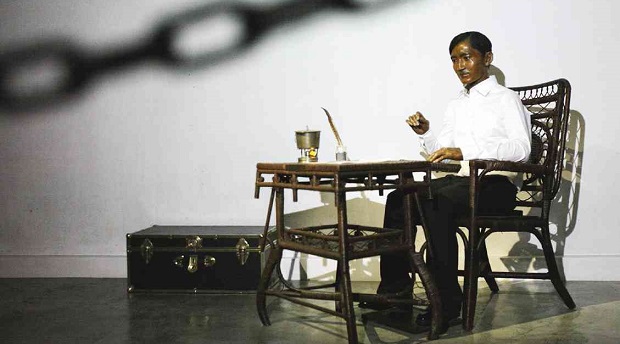Museum lets e-learners catch up with ‘eternally young’ Rizal

A MARTYR’S MIDNIGHT A life-size image of Dr. Jose Rizal, the centerpiece of a newly upgraded museum depicting his life and legacy in Fort Santiago, captures the national hero in his last hours before his 1896 execution. NINO JESUS ORBETA
The man himself is “eternally young,” hence the place celebrating his heroism should be e-qually appealing.
A modernized shrine and museum on the life and legacy of national hero Dr. Jose Rizal, complete with interactive displays and cyberstations, was opened Friday at Fort Santiago, Intramuros, Manila, his place of incarceration before he was put to death by the Spanish colonial regime on Dec. 30, 1896.
“The quality of our future is determined by the clarity with which we view our past,” Tourism Secretary Ramon Jimenez said at the inauguration of the newly improved Rizal Shrine Museum and the complementing e-Learning Room.
Maria Serena Diokno, chair of the National Historical Commission of the Philippines, said the renovation took more than a year in line with the NHCP’s program to modernize 22 museums under its supervision by 2016.
The commission hopes to enhance visitor experience and entice especially the youth to revisit history through audiovisuals and interactive displays depicting the life of Rizal—a nationalist, poet, novelist, artist, ophthalmologist and polyglot—who was charged with rebellion and put to death by firing squad at age 35.
Article continues after this advertisementThe shrine itself used to be the hero’s prison cell during his trial. Today, the entrance has been renovated to showcase a timeline of the events leading to Rizal’s death, as context is important in appreciating the hero’s place in Philippine history, according to Diokno. An interactive touchscreen panel provides additional information.
Article continues after this advertisement“In our modernized museums, we strive to make at least 50 percent of the displays interactive, in contrast to the usual 100-percent static displays,” the NHCP chair added.
Visitors can return to Rizal’s moments in the courtroom in the audio-equipped Silid Paglilitis (Trial Room) or get a glimpse of his medical practice with a view of his surgical instruments and other memorabilia. More visual highlights are available in Silid Pamana (Legacy Room).
Diokno, Jimenez and Education Secretary Armin Luistro also led the opening of an e-Learning facility a few steps away from the shrine, equipped with 10 computers, Internet access and interactive history materials produced by the commission and accessible at elearning.
nhcp.gov.ph.
The e-Learning facility used to be just a storage room. It was restored for modern use without tearing down the structure, an example of adaptive reuse, Diokno noted.
In front of the e-Learning room, the NHCP also installed a gallery of Rizal’s poem “Mi Ultimo Adios (My Last Farewell),” written as he neared execution, and its translations in various languages and even in braille.
There is no entrance fee for NHCP’s modernized museums at the moment but the commission would soon collect a reasonable fee for maintenance and restoration, Diokno said.
Jimenez commended the NHCP for “turning the museum into what it’s meant to be, not just a preserved place and not just to honor someone but to instruct the future and, in effect, direct it.”
“Rizal is not just an inspiration. Rizal is the future Filipino— inventive, creative and, as history eventually decided, eternally young,” Jimenez said.